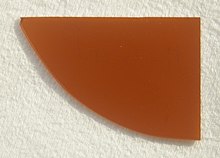 GaP ingots (impure)
| |
 GaP wafer (electronic device quality)
| |

| |
| Names | |
|---|---|
| IUPAC name
Gallium phosphide
| |
| Other names
Gallium(III) phosphide
gallanylidynephosphane | |
| Identifiers | |
3D model (JSmol)
|
|
| ChemSpider | |
| ECHA InfoCard | 100.031.858 |
PubChem CID
|
|
| RTECS number |
|
| UNII | |
CompTox Dashboard (EPA)
|
|
| |
| |
| Properties | |
| GaP | |
| Molar mass | 100.697 g/mol[1] |
| Appearance | pale orange solid |
| Odor | odorless |
| Density | 4.138 g/cm3[1] |
| Melting point | 1,457 °C (2,655 °F; 1,730 K)[1] |
| insoluble | |
| Band gap | 2.24 eV (indirect, 300 K)[2] |
| Electron mobility | 300 cm2/(V·s) (300 K)[2] |
| -13.8×10−6 cgs[2] | |
| Thermal conductivity | 0.752 W/(cm·K) (300 K)[1] |
Refractive index (nD)
|
2.964 (10 µm), 3.209 (775 nm), 3.590 (500 nm), 5.05 (354 nm)[3] |
| Structure | |
| Zinc blende | |
| T2d-F-43m | |
a = 544.95 pm[4]
| |
| Tetrahedral | |
| Thermochemistry | |
Std enthalpy of
formation (ΔfH⦵298) |
−88.0 kJ/mol[5] |
| Hazards | |
| NFPA 704 (fire diamond) | |
| Flash point | 110 °C (230 °F; 383 K) |
| Related compounds | |
Other anions
|
Gallium nitride Gallium arsenide Gallium antimonide |
Other cations
|
Aluminium phosphide Indium phosphide |
Except where otherwise noted, data are given for materials in their standard state (at 25 °C [77 °F], 100 kPa).
| |
Gallium phosphide (GaP), a phosphide of gallium, is a compound semiconductor material with an indirect band gap of 2.24 eV at room temperature. Impure polycrystalline material has the appearance of pale orange or grayish pieces. Undoped single crystals are orange, but strongly doped wafers appear darker due to free-carrier absorption. It is odorless and insoluble in water.
GaP has a microhardness of 9450 N/mm2, a Debye temperature of 446 K (173 °C), and a thermal expansion coefficient of 5.3 ×10−6 K−1 at room temperature.[4] Sulfur, silicon or tellurium are used as dopants to produce n-type semiconductors. Zinc is used as a dopant for the p-type semiconductor.
Gallium phosphide has applications in optical systems.[6][7][8] Its static dielectric constant is 11.1 at room temperature.[2] Its refractive index varies between ~3.2 and 5.0 across the visible range, which is higher than in most other semiconducting materials.[3] In its transparent range, its index is higher than almost any other transparent material, including gemstones such as diamond, or non-oxide lenses such as zinc sulfide.
- ^ a b c d Haynes, p. 4.63
- ^ a b c d Haynes, p. 12.85
- ^ a b Haynes, p. 12.156
- ^ a b Haynes, p. 12.80
- ^ Haynes, p. 5.20
- ^ Wilson, Dalziel J.; Schneider, Katharina; Hönl, Simon; Anderson, Miles; Baumgartner, Yannick; Czornomaz, Lukas; Kippenberg, Tobias J.; Seidler, Paul (January 2020). "Integrated gallium phosphide nonlinear photonics". Nature Photonics. 14 (1): 57–62. arXiv:1808.03554. doi:10.1038/s41566-019-0537-9. ISSN 1749-4893. S2CID 119357160.
- ^ Cambiasso, Javier; Grinblat, Gustavo; Li, Yi; Rakovich, Aliaksandra; Cortés, Emiliano; Maier, Stefan A. (2017-02-08). "Bridging the Gap between Dielectric Nanophotonics and the Visible Regime with Effectively Lossless Gallium Phosphide Antennas". Nano Letters. 17 (2): 1219–1225. Bibcode:2017NanoL..17.1219C. doi:10.1021/acs.nanolett.6b05026. hdl:10044/1/45460. ISSN 1530-6984. PMID 28094990.
- ^ Rivoire, Kelley; Lin, Ziliang; Hatami, Fariba; Masselink, W. Ted; Vučković, Jelena (2009-12-07). "Second harmonic generation in gallium phosphide photonic crystal nanocavities with ultralow continuous wave pump power". Optics Express. 17 (25): 22609–22615. arXiv:0910.4757. Bibcode:2009OExpr..1722609R. doi:10.1364/OE.17.022609. ISSN 1094-4087. PMID 20052186. S2CID 15879811.
